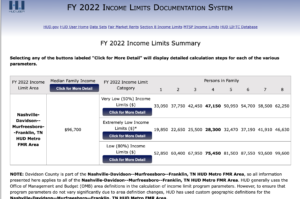
There are only six families still living in the Riverchase apartments in East Nashville.
Once they’re gone, Texas-based developer CREA plans to knock down the complex to create a mixed-use development. The land is in walking distance to the incoming Oracle tech campus.
The property will have housing for just about every income level. The diverse supply of units will help add to the city’s tight housing stock.
The developer will build more affordable units at Riverchase than currently exists. But there’s a catch.
Overall, around 1,150 units will be created, with 80% of those at the market rate. Pricing will be based on similar apartments in the North Gulch, Germantown and East Nashville areas.
The other 20% (or 225 units) will be “affordable.” The definition just means a person spends 30% of their income on housing costs. So it doesn’t just apply to people earning low incomes.
Here’s the breakdown on how many units will be set aside for each household income level, based on the Area Median Income:
- 25 units for a two-person household income between $78,134 and $92,834 or four-person household income between $97,667 and $116,040 (120% AMI limit)
- 100 units for a two-person household income between $46,055 and $60,400 or four-person household income between $75,440 and $57,523 (80% AMI limit)
- 50 units for a two-person household income between $45,300 and $30,955 or four-person household income between $56,580 and $38,663 (60% AMI limit)
- 30 units for a two-person household income at or below $45,300 and $30,955 or four-person household income between $56,580 and $38,663 (60% AMI limit)
- 20 units for a two-person household income at or below $30,200 or four-person household income at or below $37,720 (40% AMI limit)
This is laid out in CREA and the Urban League of Middle Tennessee’s community benefits agreement, which will take effect sometime this fall. Once it’s active, the deed for the property will require all future owners to abide by the agreement for the length of the contract.
 .
.
A recent community meeting raises concerns about displaced residents and the future
Residents recently described their belongings being gone before fully moving out and raised questions about people not being able to move back.
“You’ve talked about how a lot of residents were underserved,” Ida B. Wells Elementary teacher Bernard Lafayette III says. “You even admitted it was wrong. My question is: How do you see that being a model for other developers?”
Development manager Stephen Buchanan points to displaced Riverchase residents being able to return once the new units are built. “And that if anything is more of a model than anything else we might have,” he says.
But half of Riverchase residents use a housing voucher to pay for rent. In order to qualify for the government subsidy, you have to earn at or below 50% the area median income. The U.S. Department of Housing and Urban Development says that’s about $47,150 for a family of four. Right now, the new development only guarantees 20 units at this level, which isn’t enough spots for everyone to return.
There is potential for more units to be built
CREA is looking for a nonprofit development partner so they can get low income housing tax credits to build at least 120 affordable units. Of those, 23 would be two-bedroom and 11 would be three-bedroom units. During the search, one factor CREA will judge nonprofits on is how many units they can build and on the population the group serves, as well as the nonprofit’s ability to meet LIHTC and CBA requirements.
The Metro Council’s rezoning of the Riverchase property, meanwhile, is being held up to iron out some development changes around the height of a building.
The public hearing scheduled for Aug 2nd regarding proposed redevelopment of Riverchase will be deferred until September.
The applicant has proposed height modifications which I will review with Planning staff and share with the community as soon as possible pic.twitter.com/bsn0nnDn7Q
— Sean Parker (@SeanForFive) July 30, 2022

